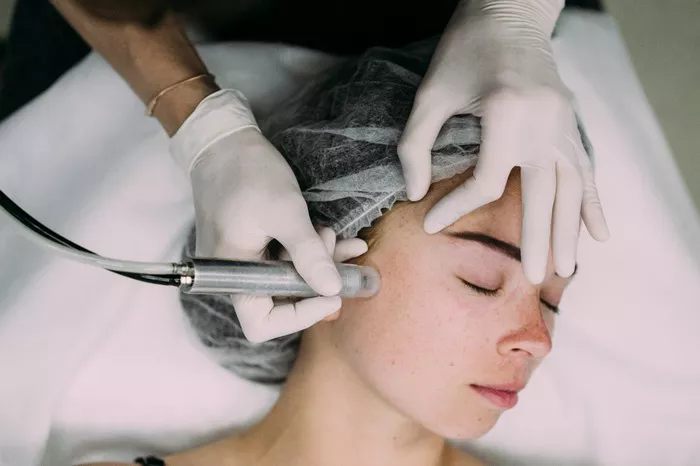Microdermabrasion is a popular skincare treatment that offers a range of benefits for improving skin texture, tone, and overall appearance. It involves exfoliating the outermost layer of the skin to reveal fresher and smoother skin underneath. While professional microdermabrasion treatments are available at clinics and spas, you can also achieve similar results at home without the need for a specialized machine. In this article, we will explore the benefits of microdermabrasion for your skin and provide a step-by-step guide on how to perform microdermabrasion at home without a machine.
Understanding Microdermabrasion Benefits
Microdermabrasion offers several advantages for the skin:
Exfoliation: The primary benefit of microdermabrasion is the removal of dead skin cells from the surface of the skin. This exfoliation process promotes cell turnover, revealing fresher and healthier skin.
Improved Texture: By exfoliating the skin, microdermabrasion helps to smooth out rough or uneven skin texture, leaving the skin feeling softer and more refined.
Reduced Fine Lines and Wrinkles: Microdermabrasion stimulates collagen production, which can lead to a reduction in the appearance of fine lines and wrinkles over time.
Minimized Pores: Exfoliation can help unclog pores and minimize their appearance, leading to a smoother complexion.
Enhanced Absorption: After exfoliation, the skin is better able to absorb skincare products, allowing them to penetrate more effectively and deliver better results.
Radiant Complexion: Microdermabrasion can help improve skin tone and promote a more radiant and glowing complexion.
How to Do Microdermabrasion at Home Without a Machine
Performing microdermabrasion at home without a machine is possible by using manual exfoliation techniques. Here’s a step-by-step guide:
Step 1: Cleanse Your Skin
Start by cleansing your face thoroughly to remove any makeup, dirt, and impurities. Use a gentle cleanser suitable for your skin type. Pat your skin dry with a clean towel.
Step 2: Exfoliation
For this step, you’ll need a physical exfoliant, such as a facial scrub or exfoliating cleanser. Choose a product with fine exfoliating particles that won’t be too harsh on your skin. Gently massage the exfoliant onto your damp skin using circular motions. Focus on areas with rough texture or concerns, but be careful not to over-exfoliate.
Step 3: Create a DIY Exfoliating Paste
You can create a simple DIY exfoliating paste using ingredients from your kitchen. Combine equal parts of baking soda and water to form a paste. Apply the paste to your face, avoiding the delicate eye area. Gently massage in circular motions for a minute or two before rinsing thoroughly.
Step 4: Steam Your Face
Steaming your face helps to open up your pores and soften the skin for deeper exfoliation. Boil water, transfer it to a bowl, and let it cool slightly. Position your face over the bowl, creating a tent with a towel, and allow the steam to envelop your skin for about 5-10 minutes.
Step 5: Manual Extraction (Optional)
If you’re comfortable with manual extraction, you can gently remove blackheads and whiteheads using clean, sanitized extraction tools. However, exercise caution to avoid damaging your skin. If you’re unsure, it’s best to skip this step.
Step 6: Apply a Soothing Mask
After exfoliation, your skin may be slightly sensitive. Apply a soothing and hydrating mask to replenish moisture and calm your skin. Opt for a mask suitable for your skin type, whether it’s hydrating, calming, or clarifying.
Step 7: Moisturize and Protect
Finish your at-home microdermabrasion session by applying a moisturizer that suits your skin’s needs. Don’t forget to apply sunscreen if you’re performing the treatment during the day, as exfoliated skin is more susceptible to sun damage.
Frequency of At-Home Microdermabrasion
The frequency of at-home microdermabrasion depends on your skin’s sensitivity and needs. For most people, once a week is sufficient. However, if you have sensitive skin, you might want to start with once every two weeks to avoid over-exfoliation.
Precautions and Considerations
While at-home microdermabrasion can provide benefits, it’s important to take some precautions:
Avoid Harsh Scrubs: Choose exfoliants with gentle exfoliating particles to avoid damaging your skin.
Be Gentle: During the exfoliation process, be gentle and avoid aggressive scrubbing, as it can lead to irritation.
Skip Broken Skin: Avoid performing microdermabrasion on areas with cuts, wounds, or active breakouts.
Patch Test: If you’re using a DIY exfoliating paste, perform a patch test on a small area of your skin to ensure you don’t have any adverse reactions.
Follow Up with Skincare: After microdermabrasion, use a hydrating and soothing skincare routine to support your skin’s healing process.
Conclusion
Microdermabrasion is a versatile treatment that can offer numerous benefits for your skin. While professional treatments are available, you can achieve similar results at home without a machine by using manual exfoliation techniques. By exfoliating the skin, promoting cell turnover, and revealing a smoother complexion, microdermabrasion can contribute to a healthier and more radiant appearance. Remember to be cautious, follow the recommended steps, and tailor your at-home microdermabrasion routine to your skin’s individual needs for the best results.


